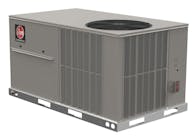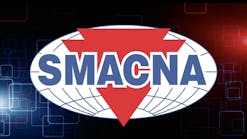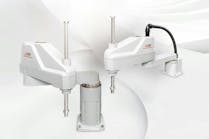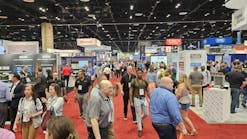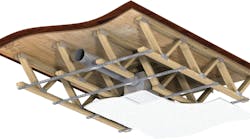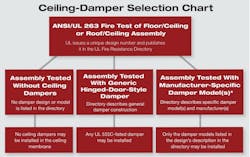Editor’s note: The following is adapted from the white paper “Ceiling Dampers Explained”1 by the AMCA International Damper Engineering Committee.
By MICHAEL J. BULZOMI, AMCA International, Fire and Smoke Damper Subcommittee
Ceiling dampers, wood-truss ceiling dampers, ceiling fire dampers, firestop flaps—ceiling radiation dampers go by many names but serve one very important purpose: limit the transfer of heat through HVAC penetrations in ceiling membranes (most commonly, fire-rated acoustical ceiling tile or gypsum board) protecting the structural members of a fire-resistance-rated floor/ceiling or roof/ceiling assembly in the event of a fire. (Figure 1)
Selecting the proper ceiling radiation damper—even understanding if a ceiling radiation damper is applicable—for a given application can be confusing. This article will explain how to determine the correct ceiling radiation damper based on the assembly used in construction.
ANSI/UL 263 and UL’s Fire Resistance Directory
The process of selecting a ceiling radiation damper depends largely on the design of the floor/ceiling or roof/ceiling assembly in which the ceiling radiation damper will be installed. ANSI/UL 263, Fire Tests of Building Construction and Materials2, defines test criteria used to evaluate entire floor/ceiling and roof/ceiling assemblies, as opposed to components of assemblies. If a floor/ceiling or roof/ceiling assembly meets the test criteria, it receives a fire-resistance rating expressed in terms of hours, and its design specifications are added to UL’s Fire Resistance Directory (Product iQ).
Floor/ceiling and roof/ceiling assemblies requiring membrane protection can be tested to ANSI/UL 263 any of three ways (Figure 2):
- Without ceiling radiation dampers—Installation of ceiling radiation dampers in assemblies tested without HVAC penetrations through their ceiling membranes is prohibited. If the use of ceiling radiation dampers is not called out in the construction details of an assembly in the Fire Resistance Directory, the design should not be specified for or used in applications requiring HVAC penetrations through ceiling membranes;
- With generic hinged-door-type dampers—A hinged-door-type damper is a design not specific to a given manufacturer. In ANSI/UL 263 tests of floor/ceiling and roof/ceiling assemblies, it often is employed so as not to restrict the type of damper that can be used in the construction of a building. In actual building construction, however, it rarely is used. (Note: Standard ceiling radiation dampers tested to UL 555C, Ceiling Dampers3, are intended for use only in assemblies initially tested and listed with a hinged-door-type damper. Typical applications include fire-rated lay-in acoustical-tile ceilings in steel-truss assemblies rated for up to three hours of fire resistance);
- With manufacturer-specific damper models—When a floor/ceiling or roof/ceiling assembly is fire-tested with a manufacturer-specific damper, that damper model will be specified in the Fire Resistance Directory, and only that damper can be installed.
A company or an organization that contracts UL to conduct an ANSI/UL 263 test of a building element is the “sponsor” of the test and has final say on the products used in the design. Typically, damper manufacturers allow only their damper models or damper models they produce and license for other manufacturers to be listed in designs they sponsor. The result is that many damper manufacturers have their own floor/ceiling and roof/ceiling design numbers in the Fire Resistance Directory, despite, in many cases, the construction of the test assembly, with the exception of the dampers—that is, the flooring system, structural members, gypsum board, etc.—being identical to that of other designs. This is what is known as a “proprietary” design. An “open” design is one for which any product that passes required testing can be listed by UL as approved for use.
International Building Code
According to the International Building Code (IBC)4, ceiling radiation dampers shall comply with the requirements of UL 555C or be tested as part of a fire-resistance-rated floor/ceiling or roof/ceiling assembly in accordance with ASTM E119, Standard Test Methods for Fire Tests of Building Construction and Materials5, or ANSI/UL 263. Ceiling radiation dampers are not required to be UL-listed; other third-party agencies can test and certify dampers to the required standard.
For example, Intertek is Occupational Safety and Health Administration (OSHA) Nationally Recognized Testing Laboratory (NRTL) Program-recognized to test products to the specifications of applicable product safety standards and can test and list a damper to an applicable test standard. It is not uncommon to see a ceiling radiation damper bearing Intertek’s Warnock Hersey or ETL Listed mark, which demonstrates compliance with the requirements of widely accepted product safety standards, as determined through independent testing and periodic follow-up inspections. The Warnock Hersey and ETL Listed marks include the same testing, listing, labeling, and follow-up-inspection services as competing certification marks, such as UL and CSA, and are accredited by the same organizations, agencies, and regulatory bodies.
The guidelines for UL directory listings apply for Intertek directory listings. Intertek typically lists products for use in specific applications, references specific UL designs, and tests for compliance with applicable UL standards, as required by the IBC.
Summary
An entire floor/ceiling or roof/ceiling assembly—ceiling radiation damper, truss, gypsum board, etc.—must be tested and listed to ANSI/UL 263 to be used in a specific application. Just as a UL 555, Fire Dampers-classified fire damper cannot be substituted for a UL 555C-classified ceiling radiation damper, a UL 555C-classified ceiling radiation damper cannot be substituted for an ANSI/UL 263-classified wood-truss ceiling-damper assembly with the assembly’s UL fire-resistive rating maintained, if the damper was not tested and approved for the assembly.
Fire-rated floor/ceiling and roof/ceiling assemblies requiring membrane protection can be tested any of three ways:
- Without ceiling radiation dampers, in which case they are prohibited from being specified or used in applications requiring HVAC penetrations through ceiling membranes;
- With generic hinged-door-type dampers, in which case any UL 555C-approved damper may be installed;
- With a manufacturer-specific damper model, in which case only the damper identified in the listing agency’s directory may be installed. All designs of combustible wood-truss or wood-joist floor/ceiling or roof/ceiling assemblies permitting ceiling radiation dampers require the use of manufacturer-specific damper models. Dampers with only UL 555C approval may not be used in combustible assemblies.
When a rated floor/ceiling or roof/ceiling assembly containing a manufacturer-specific damper model (e.g., a fire-rated wood-truss assembly used in multifamily construction) is used, cooperation between the project architect and the mechanical engineer in coordinating construction specifications of rated barriers and HVAC products is critical. If specific requirements of the HVAC system must be met, then the architect must be sure to specify the correct listed assembly. Consulting with the local authority having jurisdiction is recommended to ensure project requirements can be met and to discuss any installation concerns.
References
1 AMCA. (2018). Ceiling dampers explained. Arlington Heights, IL: Air Movement and Control Association International. Retrieved from https://bit.ly/CDExplained;
2 UL. (2011). Fire tests of building construction and materials. ANSI/UL 263. Northbrook, IL: UL;.
3 UL. (2014). Ceiling dampers. UL 555C. Northbrook, IL: UL;
4 ICC. (2021). International building code (ch. 7). Washington, DC: International Code Council;
5 ASTM. (2022). Standard test methods for fire tests of building construction and materials. ASTM E119. West Conshohocken, PA: ASTM International.
##########
Michael J. Bulzomi is product manager, commercial dampers, for Greenheck and chair of the AMCA Fire and Smoke Damper Subcommittee.

